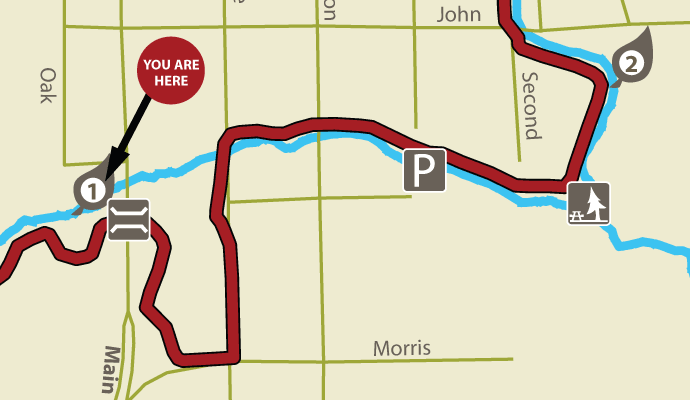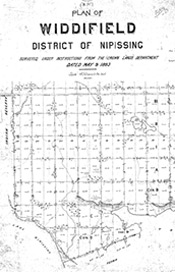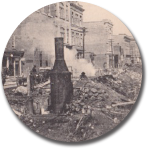"Once upon a time, when North Bay was growing, Chippewa Creek was very polluted! I could hardly breathe through my gills. Thanks for putting your garbage in a container and for keeping your dog's poop out of the Creek. You're making me smile!"


Impact of City Growth
Chippewa Creek’s health is connected to the building of the city during the late 1800s. In these early years, North Bay’s economy prospered from the lumber industry and the establishment of three railway companies. The Creek was used as a source of energy and water for a sawmill as well as the New Ontario Brewing Company's brewery which dumped its waste mash directly into the Creek. As the population grew, the Creek was also used as an open sewer. In 1891, it was considered but discounted as a source of drinking water for the young town, so it was thought to be polluted way back then. In 1894 there was a five acre dump at the east end of Main St. across from the Creek.
Chippewa Creek was likely named when the Canadian Pacific Railway (CPR) arrived in 1882, its name first appearing on maps produced around this time. By 1886 the settlement of North Bay was established and Chippewa Creek is referenced by name in early council minutes. North Bay was incorporated as a town in 1891, a city in 1925 and amalgamated with the townships of West Ferris and Widdifield in 1968.

Kinsmen Trail
In the early 1990s, the North Bay-Mattawa Conservation Authority (NBMCA), the City of North Bay and the North Bay Kinsmen Club envisioned the development of a pedestrian pathway connecting the escarpment at Airport Road to North Bay’s waterfront.
Today, the seven km Kinsmen Trail follows Chippewa Creek as it meanders down the highlands above the city through the heart of North Bay and empties into Lake Nipissing. The Trail presents countless opportunities for recreation, education and healthy, active transportation. It's the perfect paved surface for bikers and in-line skaters and its easy grade makes walking and jogging comfortable for those who are young or young at heart.
The Trail safely crosses busy Main Street via an overhead bridge linking to the Kate Pace Way at the Lake Nipissing waterfront. Kate Pace Way, a 12.8 km multi-use Trail, links the North Bay Waterfont Park to Callander and the Cranberry Trail. The Trail is named after North Bay native and alpine ski Olympian Kate Pace.
The Chippewa Creek EcoPath stretches from the waterfront to Thomson Park, along 3.2 km of the Kinsmen Trail. The EcoPath, Kinsmen Trail and the Kate Pace Way are co-managed by NBMCA and the City of North Bay.


Progress towards Recovery
By 1943, the pollution of Chippewa Creek by sewage was a very serious issue that dominated City Council discussions. The Creek was an open sanitary and storm sewer conduit for the surrounding houses and businesses which were often flooded in the spring and during heavy rain. In 1952 all the 500 outhouses along the Creek were decommissioned and a site for a sewage treatment plant was identified. The original sewage plant was built in 1961, expanded in 1973 and upgraded in 1984 with the ability to capture most phosphorus.
The de-watered sludge produced as a result of the wastewater treatment process was taken to the Marsh Dr. Landfill Site and mixed with native soils and recovered road salt and used to provide a thick permanent cover to the landfill. Since 2011, the Wastewater Treatment Plant’s sludge is taken to the Merrick Landfill Site.
Water impacted by the Marsh Drive Landfill Site in the 1970’s and 1980’s made its way to the Creek until 1989 when the Landfill Site was fitted with a Leachate Collection and Pumping System to divert a significant amount of the impacted water from the landfill to the Wastewater Treatment Plant for treatment. This allowed any remaining contaminants in the landfill impacted water to be naturally cleansed to meet Provincial Water Quality Objectives prior to entering Chippewa Creek. Since closure of the Marsh Landfill Site in 1994 and the implementation of the System, the quality of the water in Chippewa Creek has improved significantly. Annual test results of the water at the former landfill site and at the point where it enters the Creek shows that the former landfill no longer affects the water quality of the Creek.



